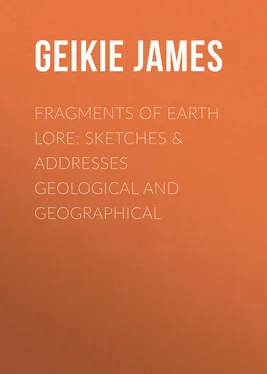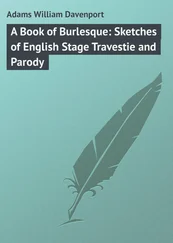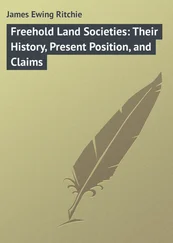James Geikie - Fragments of Earth Lore - Sketches & Addresses Geological and Geographical
Здесь есть возможность читать онлайн «James Geikie - Fragments of Earth Lore - Sketches & Addresses Geological and Geographical» — ознакомительный отрывок электронной книги совершенно бесплатно, а после прочтения отрывка купить полную версию. В некоторых случаях можно слушать аудио, скачать через торрент в формате fb2 и присутствует краткое содержание. Жанр: foreign_antique, foreign_prose, на английском языке. Описание произведения, (предисловие) а так же отзывы посетителей доступны на портале библиотеки ЛибКат.
- Название:Fragments of Earth Lore: Sketches & Addresses Geological and Geographical
- Автор:
- Жанр:
- Год:неизвестен
- ISBN:нет данных
- Рейтинг книги:4 / 5. Голосов: 1
-
Избранное:Добавить в избранное
- Отзывы:
-
Ваша оценка:
- 80
- 1
- 2
- 3
- 4
- 5
Fragments of Earth Lore: Sketches & Addresses Geological and Geographical: краткое содержание, описание и аннотация
Предлагаем к чтению аннотацию, описание, краткое содержание или предисловие (зависит от того, что написал сам автор книги «Fragments of Earth Lore: Sketches & Addresses Geological and Geographical»). Если вы не нашли необходимую информацию о книге — напишите в комментариях, мы постараемся отыскать её.
Fragments of Earth Lore: Sketches & Addresses Geological and Geographical — читать онлайн ознакомительный отрывок
Ниже представлен текст книги, разбитый по страницам. Система сохранения места последней прочитанной страницы, позволяет с удобством читать онлайн бесплатно книгу «Fragments of Earth Lore: Sketches & Addresses Geological and Geographical», без необходимости каждый раз заново искать на чём Вы остановились. Поставьте закладку, и сможете в любой момент перейти на страницу, на которой закончили чтение.
Интервал:
Закладка:
Thus it will be seen that an anticlinal arch is a weak structure – a mountain so constructed falls a ready prey to the denuding agents; and hence in regions which have been exposed to denudation for as long a period as the Scottish or Scandinavian uplands, a mountain formed of anticlinally arranged strata is of very exceptional occurrence. When it does appear, it is only because the rocks of which it is composed happen to be of a more enduring character than those of the adjacent tracts. The Ochil Hills exemplify this point. These hills consist of a great series of hard igneous rocks, which are arranged in the form of a depressed anticlinal arch – the low grounds lying to the north and south being composed chiefly of sandstones and shales. Here it is owing to the more enduring character of the igneous rocks that the anticlinal arch has not been entirely removed. We know, however, that these igneous rocks were formerly buried under a great thickness of strata, and that their present appearance at the surface is simply the result of denudation.
If an anticlinal arch be a weak structure, a synclinal arrangement of strata is quite the opposite. In the case of the former each bed has a tendency to slip or slide away from the axis, while in a syncline it is just the reverse – the strata being inclined towards and not away from the axis. Underground water, springs, and frost are enabled to play havoc with anticlinal strata, for the structure is entirely in their favour. But in synclinal beds the action of these powerful agents is opposed by the structure of the rocks – and great rock-falls and landslips cannot take place. Synclinal strata therefore endure, while anticlinal strata are worn more readily away. Even in a true mountain-range so young as the Alps, denudation has already demolished many weakly-built anticlinal mountains, and opened up valleys along their axes; while, on the other hand, synclinal troughs have been converted into mountains. And if this be true of the Alps, it is still more so of much older mountain-regions, in which the original contours due to convolutions of the strata have entirely disappeared.
The mountains of such regions, having been carved out and modelled by denuding agents, are rightly termed mountains of circumdenudation , for they are just as much the work of erosion as the flat-topped and pyramidal mountains which have been carved out of horizontal strata. The Scottish Highlands afford us an admirable example of a mountainous region of undulating and often highly-flexed strata, in which the present surface-features are the result of long-continued erosion. As already remarked, this region is one of the oldest land-surfaces in the world. In comparison with it, the Pyrenees, the Alps, and the Himalayas are creations of yesterday. The original surface or configuration assumed by the rocks composing our Highland area at the time when these were first crushed and folded into anticlines and synclines had already been demolished at a period inconceivably more remote than the latest grand upheaval of the Alps. Even before the commencement of Old Red Sandstone times, our Archæan, Cambrian, and Silurian rocks had been planed down for thousands of feet, so that the bottom beds of the Old Red Sandstone were deposited upon a gently undulating surface, which cuts across anticlines and synclines alike. In late Silurian and early post-Silurian times the North-west Highlands probably existed as a true mountain-chain, consisting of a series of parallel ranges formed by the folding and reduplication of the strata. The recent observations of my friends, Professor Lapworth and Messrs. Peach and Horne, in Sutherland, have brought to light the evidence of gigantic earth-movements, by which enormous masses of strata have been convoluted and pushed for miles out of place. We see in that region part of a dissected mountain-chain. The mountain-masses which are there exposed to view are the basal or lower portions of enormous sheets of disrupted rock, the upper parts of which have been removed by denudation. In a word, the mountains of Sutherland are mountains of circumdenudation – they have been carved out of elevated masses by the long-continued action of erosion. To prove this, one has only to draw an accurate section across the North-west Highlands, when it becomes apparent that the form or shape of the ground does not correspond or coincide with the convolutions of the strata, and that a thickness of thousands of feet of rock has been denuded away since those strata were folded and fractured. All over the Highlands we meet with similar evidence of enormous denudation. The great masses of granite which appear at the surface in many places are eloquent of the result produced by erosion continued for immeasurable periods of time. Every geologist knows that granite is a rock which could only have been formed and consolidated at great depths. When, therefore, such a rock occurs at the surface, it is evidence beyond all doubt of prodigious erosion. The granite has been laid bare by the removal of the thick rock-masses underneath which it cooled and consolidated.
A glance at any map of Scotland will show that many river-valleys, and not a few lakes, of the Highlands have a north-east and south-west trend. This trend corresponds to what geologists call the strike of the strata. The rocks of the Highlands have been compressed into a series of folds or anticlines and synclines, which have the direction just stated – namely, north-east and south-west. A careless observer might therefore rashly conclude that these surface-features resembled those of the Jura – in other words, that the long parallel hollows were synclinal troughs, and that the intervening ridges and high grounds were anticlinal arches or saddle-backs. Nothing could be further from the truth. A geological examination of the ground would show that the features in question were everywhere the result of denudation, guided by the petrological character and geological structure of the rocks. Several of the most marked hollows run along the backs of anticlinal axes, while some of the most conspicuous mountains are built up of synclinal or trough-shaped strata. Ben Lawers, and the depression occupied by Loch Tay, are excellent examples; and since that district has recently been mapped in detail by Mr. J. Grant Wilson, of the Geological Survey, I shall give a section to show the relation between the form of the ground and the geological structure of the rocks. This section speaks for itself. Here evidently is a case where “valleys have been exalted and mountains made low.” A well-marked syncline, it will be observed, passes through Ben Lawers, while Loch Tay occupies a depression scooped out of an equally well-defined anticline – a structure which is just the opposite of that which we should expect to find in a true mountain-chain. It will be also noted that Glen-Lyon coincides neither with a syncline nor a fault; it has been eroded along the outcrops of the strata. Many of the north-east and south-west hollows of the Highlands indeed run along the base of what are really great escarpments – a feature which, as we have seen, is constantly met with in every region where the strata “strike” more or less steadily in one direction. In the Highlands the strata are most frequently inclined at considerable angles, so that the escarpments succeed each other more rapidly than would be the case if the strata were less steeply inclined. In no case does any north-east and south-west hollow coincide with a structural cavity. Loch Awe has been cited as an example of a superficial depression formed by the inward dip of the strata on either side. But, as was shown many years ago by my brother, A. Geikie, 5 5 Trans. Edin. Geol. Soc. vol. ii. p. 267.
this lake winds across the strike of the strata. Moreover, if it owed its existence to a great synclinal fold, why, he asks, does it not run along the same line as far as the same structure continues? It does not do so: it is not continuous with the synclinal fold, while vertical strata appear in the middle of the lake, where, as my brother remarks, they have clearly no business to be if the sides of the lake are formed by the inward dip of the schists.
Интервал:
Закладка:
Похожие книги на «Fragments of Earth Lore: Sketches & Addresses Geological and Geographical»
Представляем Вашему вниманию похожие книги на «Fragments of Earth Lore: Sketches & Addresses Geological and Geographical» списком для выбора. Мы отобрали схожую по названию и смыслу литературу в надежде предоставить читателям больше вариантов отыскать новые, интересные, ещё непрочитанные произведения.
Обсуждение, отзывы о книге «Fragments of Earth Lore: Sketches & Addresses Geological and Geographical» и просто собственные мнения читателей. Оставьте ваши комментарии, напишите, что Вы думаете о произведении, его смысле или главных героях. Укажите что конкретно понравилось, а что нет, и почему Вы так считаете.












